- Libtayo® (cemiplimab) Approved in the European Union as First and Only Immunotherapy for Adjuvant Treatment of Cutaneous Squamous Cell Carcinoma (CSCC) with High Risk of Recurrence after Surgery and Radiation Regeneron
- Understanding Second Primary Tumors in C-POST: Definitions, Incidence, and Clinical Implications of Cemiplimab Pharmacy Times
- Regeneron (REGN) EC Approves Libtayo as First Adjuvant CSCC Immunotherapy, 68% Risk Cut Stock Titan
Category: 3. Business
-
Libtayo® (cemiplimab) Approved in the European Union as First and Only Immunotherapy for Adjuvant Treatment of Cutaneous Squamous Cell Carcinoma (CSCC) with High Risk of Recurrence after Surgery and Radiation – Regeneron
-

Baker McKenzie boosts Tax practice with addition of Sebastian Ma’ilei in London | Newsroom
Leading global law firm, Baker McKenzie, has hired Sebastian Ma’ilei as a Transfer Pricing Partner in the Firm’s Tax team in London.Prior to joining the Firm, Sebastian (Seb) worked, most recently, as a Transfer Pricing Partner in the London office of Deloitte, where he has a proven track record of generating transfer pricing work on international tax planning projects and tax disputes. He has a particular focus on the financial services industry, with experience of having worked with each of the Big 4 over the course of his career.
Seb has deep experience in large scale insurance and asset management (across traditional and alternatives managers) businesses, as well as clients in the renewable and technology sectors.
Baker McKenzie’s London Managing Partner, Ed Poulton, commented:
“It gives me great pleasure to be announcing Seb’s hire into our London office. His deep client relationships, and expertise across established and emerging industries like renewables and technology will be a tremendous asset to our team.”
Head of Tax in London at the Firm, Jessica Eden added:
“Seb’s stellar experience in transfer pricing for insurance and reinsurance clients is the perfect complement to our top tier tax practice.”
Seb joins the Firm on 1 December.
Baker McKenzie continues to accelerate aggressively its lateral growth strategy to add senior talent to its bench in London. Most recently, this has included Tax Partner, Sam Trowbridge, M&A Partner, Helen Johnson, Private Equity Real Estate Partner, Mark Thompson, Investment Funds Partner, Nick Benson, Energy & Infrastructure Partner, James Wyatt, Restructuring & Insolvency Partner, Kevin Heverin, Patent Litigation Partner, Indradeep Bhattacharya, and Corporate M&A Partner, Michal Berkner.
With more than 2,700 deal practitioners in 45 jurisdictions, Baker McKenzie is a transactional powerhouse. The Firm excels in complex, cross-border transactions; over 65% of our deals are multijurisdictional. Baker McKenzie has been consistently recognised as a top-three firm for cross-border M&A by volume over the past decade. The teams are a hybrid of ‘local’ and ‘global,’ combining money-market sophistication with local excellence.
Baker McKenzie’s Tax team is among the most highly rated and recommended tax advisers worldwide, top ranked by international tax directories in more jurisdictions than any other law firm.
Continue Reading
-

BBVA’s strategy for a Black Friday and Christmas alongside its customers
Until 30 November 2025, anyone who opens a BBVA account in Italy and activates their card (physical or digital) will receive 10% cashback on purchases made during the first month, up to a maximum of €50 cashback credited directly to the account.
And that’s not all: for the following six months, every payment continues to bring satisfaction with 3% cashback on the first €280 of monthly purchases, for a total of up to an additional €50 in cashback.
Whether it’s a new Black Friday smartphone, Christmas gifts for the kids, or the holiday dinner, BBVA gives you back part of what you spend—a smart way to turn inevitable expenses into a small gain.
Liquidity that works for you: 3% gross interest on your balance
Your liquidity can celebrate too: BBVA offers 3% gross interest on the balance of your current account for the first six months, up to €1 million, with no restrictions, minimum amounts, or the need to open a savings or deposit account.
It’s a completely free current account, with full access to your funds—you can make transfers, withdrawals, and payments at any time. So while you think about gifts, your money keeps working for you.
“Black Friday and the Christmas holidays are times when we all tend to spend a little more — and we want to meet Italians’ needs by making this period more rewarding than ever,” says Walter Rizzi, BBVA Country Manager for Italy. “With Great Cashback, part of your spending goes straight back into your account, while with the remunerated liquidity, even the money you don’t spend continues to grow. It’s the perfect combination for those who want to manage their finances smartly, even during the busiest time of the year.”
Continue Reading
-

Østnes Helicopters orders 10 H125 helicopters
Cologne, Germany, 19 November 2025 – Airbus and Østnes Helicopters, the official distributor for Airbus Helicopters in the Nordic countries, announced a contract for 10 Airbus H125s at this year’s European Rotors. This order, when combined with four H125s already booked earlier in 2025, brings the total number of H125s ordered through Østnes Helicopters this year to 14 aircraft.
“Our customers require a rotorcraft that is not just reliable, but truly versatile, capable of performing everything from long-line utility work to passenger transport. The H125 delivers on all fronts, and we see a continuous strong demand for the helicopter on the Nordic market. This strategic procurement ensures we can maintain short delivery times and offer our customers the best availability for the world’s most successful single-engine helicopter,” said Stine Østnes, Chief Sales Officer of Østnes Helicopters.
“The unwavering demand for the H125 in the Nordics is a clear testament to its unmatched versatility and performance,” said Thomas Hein, Head of Europe Region at Airbus Helicopters. “The H125 is engineered to excel in the most demanding conditions, and this total of 14 orders in 2025 affirms its position as the preferred tool for customers across the Nordic countries. We are proud to continue this journey of growth and partnership with Østnes Helicopters.”
Østnes Helicopters has solidified a strong presence within the region’s rotorcraft sector, having successfully facilitated the sale of more than 400 helicopters across both the new and secondary markets. The company’s maintenance organisation is approved to deliver full Maintenance, Repair, and Overhaul (MRO) services for the H120, H125, and H130 models. Furthermore, its operational scope encompasses full support for the H145, which is delivered by a dedicated team of certified technicians and avionics experts specially trained for the H145 helicopter.
There are more than 130 H125s in the Nordics, which mainly perform utility and aerial work missions. Across the globe, there are more than 4,300 H125 family helicopters flying in the most demanding conditions. The H125 belongs to the renowned Ecureuil family, the absolute market leader in the intermediate single-engine helicopter category, achieving a market share of 73% in 2024.
@AirbusHeli #H125 #MakingMissionsPossible #EuropeanRotors2025
Continue Reading
-
Antananarivo Dangerous Cargo Inland Fee 2025
Maersk constantly strives to provide more reliable and innovative products. We offer the broadest coverage and competitive transit times at an unmatched reliability.
To continue offering our broad portfolio of services and high level of reliability, we are implementing – Origin Dangerous Cargo Service (Inland Haulage)- for the below said location in Madagascar with effective from 18th December 2025 for Regulated countries and 19th November 2025 for Non-Regulated countries.
The implemented tariff amount is detailed as follows:
Container Size Type – All containers
For your reference, you can also use our inland price look-up feature to find inland rates & its related mandatory surcharges online via Maersk.com that are already included in your existing contract or look up our tariff rates.
We appreciate your business and look forward to continuing working with you in the future.
Continue Reading
-

Nokia announces new strategy, evolution of its operating model, new long-term financial target, strategic KPIs and changes to its Group Leadership Team
Nokia Corporation
Stock Exchange Release
19 November 2025 at 13:00 EETNokia announces new strategy, evolution of its operating model, new long-term financial target, strategic KPIs and changes to its Group Leadership Team
Espoo, Finland – Nokia is holding its Capital Markets Day 2025 today and announcing its strategy to position itself to lead in the AI-driven transformation of networks and capture the value of the AI supercycle. Nokia also announces new long-term financial target, strategic KPIs for the business, an evolution of its operating model and changes to its Group Leadership Team. To execute on its new strategic direction, Nokia is simplifying its operational model into two primary operating segments of Network Infrastructure and Mobile Infrastructure. These changes are intended to put Nokia on a stronger path to innovate, serve its customers and create shareholder value. The company now targets to grow its annual comparable operating profit to a range of EUR 2.7 to 3.2 billion by 2028.
“Nokia changed the world once by connecting people — and will again by connecting intelligence,” said Justin Hotard, President and CEO of Nokia. “As the trusted western provider of secure and advanced connectivity, our technology is powering the AI supercycle. From fixed to mobile infrastructure we are developing technology that accelerates value for our customers. I am proud of the work Team Nokia is doing to focus and lead this critical era in connectivity”.
The new strategy will focus on the following five strategic priorities:
- Accelerate growth in AI & Cloud
- Lead the next era of mobile connectivity with AI-native networks and 6G
- Grow by co-innovating with customers and partners
- Focus capital where Nokia can differentiate
- Unlock sustainable returns
Together, these priorities will focus Nokia on where it can lead, simplify how it operates, and strengthen its path to deliver growth and create value.
Nokia to operate with two primary operating segments
Nokia will reorganize its business into two primary operating segments to better align to customer needs and accelerate innovation as the AI supercycle increases demand for advanced connectivity. This reorganization will take effect as of 1 January 2026.The reorganization recognizes Network Infrastructure as a growth segment, positioned to capitalize on the rapid, global AI and data center build-out while continuing to innovate for its telecommunications customer base. The segment will continue to be led by David Heard and consists of three business units Optical Networks, IP Networks and Fixed Networks.
The new Mobile Infrastructure segment will bring together Nokia’s Core Networks portfolio, Radio Networks portfolio and Technology Standards, formerly Nokia Technologies. It will be positioned for core and radio network technology and services leadership to lead the industry to AI-native networks and 6G. The new segment brings together a portfolio whose value creation is founded on mobile communication technologies based on 3GPP standards with a strong cash flow position underpinned by IP licensing. It will be led by Justin Hotard on an interim basis and will consist of three business units Core Software, Radio Networks and Technology Standards.
As part of these changes, Nokia is announcing additional changes in its leadership team, effective 1 January 2026. Raghav Sahgal will take the position of Nokia’s Chief Customer Officer, and will continue in the Group Leadership Team, driving a seamless customer experience for Nokia’s customers. Patrik Hammarén will continue in the Group Leadership Team as President, Technology Standards, formerly Nokia Technologies, reflecting the significant value technology standards creates for Nokia. In addition, Tommi Uitto will step down from the Group Leadership Team, effective 31 December.
Businesses moved to newly created Portfolio Businesses segment
As part of its strategy work, Nokia has conducted a thorough review of its business portfolio. This process identified several units which despite some compelling growth opportunities, are not seen as core to the future of the company’s strategy. These units will be moved into a dedicated operating segment called Portfolio Businesses while the company assesses the best value creating opportunity for them.Nokia plans to move the following units into Portfolio Businesses:
- Fixed Wireless Access CPE (currently in Fixed Networks in Network Infrastructure)
- Site Implementation and Outside Plant (currently in Fixed Networks in Network Infrastructure)
- Enterprise Campus Edge (currently in Cloud and Network Services)
- Microwave Radio (currently in Mobile Networks)
Nokia targets to conclude on a future direction for each unit during 2026. During this transition Nokia’s priority will be to ensure continuity for customers and employees. During the past twelve months, these units generated net sales of approximately EUR 0.9 billion with an operating loss of EUR 0.1 billion.
Moving defense into dedicated unit for incubation
Nokia Defense is being launched as an incubation unit to serve as the central go-to-market and R&D hub for Nokia’s defense portfolio. Building on the strong foundation of Nokia Federal Solutions in the US, the company sees further opportunities in the US, Finland and other allied countries to deliver defense-grade solutions based on Nokia’s core technologies in Network and Mobile infrastructure.New long-term financial target and strategic KPIs
Nokia is introducing a new long-term financial target to achieve comparable operating profit of EUR 2.7 billion to EUR 3.2 billion by 2028, an increase from the EUR 2.0 billion generated in the last 12 months (Q4’24-Q3’25). This is a separate long-term target for Nokia, not part of the group level financial outlook and replaces Nokia’s prior long-term targets to grow faster than the market, achieve a comparable operating margin of at least 13% and free cash flow conversion from comparable operating profit of 55% to 85%.Nokia is exposed to different trends across its primary segments and will use different strategic levers across the company maximise shareholder value creation based on the greatest opportunities. Nokia is introducing a series of strategic KPIs which best illustrate the expected outcomes of Nokia’s strategy. These KPIs for the business are not part of the group level financial outlook.
- Net sales growth in Network Infrastructure: Nokia targets 6-8% net sales CAGR during 2025-2028. This includes a 10-12% target for the combined Optical Networks and IP Networks.
- Network Infrastructure operating margin: 13% to 17% by 2028
- Mobile Infrastructure gross margin: 48-50% by 2028
- Mobile Infrastructure operating profit: Grow from a base of EUR 1.5 billion
- Group Common and Other operating expenses: EUR 150 million operating expenses down from the current EUR 350 million run-rate by 2028.
- Free cash flow conversion: Nokia targets to deliver free cash flow conversion from comparable operating profit of between 65% and 75%.
Provisional financial information for the new segment structure
Nokia’s new segments will be established from 1 January 2026 and Nokia will begin reporting its financial results under the new segment structure beginning with its first quarter 2026 financial results. Nokia intends to publish recast financials for both 2024 and 2025 under the new reporting structure during the first quarter of 2026. Nokia is providing the below approximate provisional breakdown of the business within the new reporting framework to help investors understand the perimeter, these figures are also provided proforma for the Infinera acquisition.Q4’24 – Q3’25
(EUR billion)Net
salesGross
marginOperating profit Operating
marginNetwork Infrastructure* 7.8 43% 0.8 10% Mobile Infrastructure 11.6 48% 1.5 13% Portfolio businesses 0.9 22% -0.1 N/A Group Common and Other -0.2 N/A Nokia comparable* 20.3 45% 2.0 10% *This provisional financial information is also shown proforma for the Infinera acquisition.
Starting with its Q1 2026 financial results, Nokia will provide on a quarterly basis full segment reporting for the new segments (i.e. net sales, gross profit, operating profit) and will also provide revenue disclosure for the business units within the primary operating segments. The business units within Network Infrastructure will be Optical Networks, IP Networks and Fixed Networks. The business units within Mobile Infrastructure will be Core Software, Radio Networks and Technology Standards.
About Nokia
Nokia is a global leader in connectivity for the AI era. With expertise across fixed, mobile, and transport networks, powered by the innovation of Nokia Bell Labs, we’re advancing connectivity to secure a brighter world.Inquiries:
Nokia
Communications
Phone: +358 10 448 4900
Email: press.services@nokia.com
Maria Vaismaa, Vice President, Global Media RelationsNokia
Investor Relations
Phone: +358 931 580 507
Email: investor.relations@nokia.comFORWARD-LOOKING STATEMENTS
Certain statements herein that are not historical facts are forward-looking statements. These forward-looking statements reflect Nokia’s current expectations and views of future developments and include statements regarding: A) expectations, plans, benefits or outlook related to our strategies, projects, programs, product launches, growth management, licenses, sustainability and other ESG targets, operational key performance indicators and decisions on market exits; B) expectations, plans or benefits related to future performance of our businesses (including the expected impact, timing and duration of potential global pandemics, geopolitical conflicts and the general or regional macroeconomic conditions on our businesses, our supply chain, the timing of market changes or turning points in demand and our customers’ businesses) and any future dividends and other distributions of profit; C) expectations and targets regarding financial performance and results of operations, including market share, prices, net sales, income, margins, cash flows, cost savings, the timing of receivables, operating expenses, provisions, impairments, tariffs, taxes, currency exchange rates, hedging, investment funds, inflation, product cost reductions, competitiveness, value creation, revenue generation in any specific region, and licensing income and payments; D) ability to execute, expectations, plans or benefits related to transactions, investments and changes in organizational structure and operating model; E) impact on revenue with respect to litigation/renewal discussions; and F) any statements preceded by or including “anticipate”, “continue”, “believe”, “envisage”, “expect”, “aim”, “will”, “target”, “may”, “would”, “could“, “see”, “plan”, “ensure” or similar expressions. These forward-looking statements are subject to a number of risks and uncertainties, many of which are beyond our control, which could cause our actual results to differ materially from such statements. These statements are based on management’s best assumptions and beliefs in light of the information currently available to them. These forward-looking statements are only predictions based upon our current expectations and views of future events and developments and are subject to risks and uncertainties that are difficult to predict because they relate to events and depend on circumstances that will occur in the future. Factors, including risks and uncertainties that could cause these differences, include those risks and uncertainties identified in our 2024 annual report on Form 20-F published on 13 March 2025 under Operating and financial review and prospects-Risk factors.
';
Continue Reading
-

Africa: Rethinking plastics to unlock industrial potential
By catalysing shifts in trade and consumption, plastics policy helps power innovation and sustainable industrialization on the continent.
As the world continues seeking a treaty to end plastic pollution, Africa is not waiting to adapt but planning ahead.
Beyond short-term bans and clean-ups, the continent is working to revamp laws, markets and supply chains to steer economies towards non-plastic alternatives and substitutes as a new source of industrial growth.
Ghana: Plastic policy for industrial shift
In Ghana, a five-year implementation plan is underway to reduce plastic packaging and make sustainable alternatives more commercially viable.
The blueprint, a first in West Africa, was developed with support from the UK-funded Sustainable Manufacturing and Environmental Pollution (SMEP) Programme of UN Trade and Development (UNCTAD).
It aligns economic incentives, public procurement and key performance indicators with broader industrial strategy, currently being piloted to target the country’s most waste-heavy sectors such as plastic mulch film, sachet water packaging and carrier bags.
“This is a development strategy, not a waste strategy,” Ebenezer Laryea, a project director for SMEP on the ground, told UNCTAD ahead of this year’s Africa Industrialization Week running through 21 November.
“We’re using plastics policy to drive broader industrial shift, rethinking how we trade and consume so that sustainability and the bioeconomy shape our path to economic growth.”
The blueprint links to forthcoming Extended Producer Responsibility (EPR) rules, as the country aims for a competitive foothold in the fast-emerging global circular bioeconomy.
“Ghana’s transition provides an opportunity for both enhanced environmental protection and economic advancement, positioning the country as a hub for trade in plastic alternatives and natural substitutes,” said Director Larry Kottoe of Ghana’s Environmental Protection Authority.
East Africa: Plastic policy for green industrialization
Supported by UNCTAD’s SMEP programme, countries in East Africa also accelerate progress towards a circular and regenerative economy.
The East African Community is considering a draft bill on a regionally binding roadmap to phase out harmful single-use plastics.
The work seeks to close cross-border loopholes that often hamper national action on single-use plastics, harmonising regulations across Burundi, the Democratic Republic of the Congo, Kenya, Rwanda, Somalia, South Sudan, Uganda and the United Republic of Tanzania.
Beyond banning plastics, the draft bill mandates EPR rules, incentivizes sustainable materials and protects informal workers to formalize the waste economy.
“Plastic controls must be paired with business-enabling measures, supportive policy frameworks, sustainable finance and skills development,” concluded Abraham Korir Sing’Oei, a principal secretary at Kenya’s Ministry of Foreign and Diaspora Affairs.
Continue Reading
-

Nearly 70% of marketing leaders agree agentic AI will be transformative, yet effectiveness remains elusive
Nearly 70% of marketing leaders agree agentic AI will be transformative, yet effectiveness remains elusive – Capgemini USA
Nearly 70% of marketing leaders agree agentic AI will be transformative, yet effectiveness remains elusive – Capgemini USA
Continue Reading
-
A framework to assess the severity of adverse scenarios in EU-wide stress tests
Published as part of the Macroprudential Bulletin 32, November 2025.
The severity and the plausibility of stress test scenarios are crucial elements for interpreting the results and ensuring the credibility of stress-testing exercises. This article introduces a comprehensive framework for assessing scenario severity and plausibility in the context of the adverse scenarios used in the EU-wide stress tests. Two families of indicators are developed, characterised by a backward-looking and a forward-looking perspective. Backward-looking indicators compare the scenario with historical regularities, using as key metrics deviations from baseline projections and comparisons with the extreme values of key variables. Forward-looking indicators are drawn from macroeconomic modelling and compare the scenario with projected distributions about future economic developments incorporating the co-movement of variables within a unified analytical framework. These forward-looking metrics enable the severity assessment to account for the prevailing financial conditions and the level of systemic risk in the economy. The analysis presented suggests that the adverse scenarios used in the EU-wide stress tests have become more severe over time, peaking in the 2023 exercise and stabilising in 2025. Taking into account systemic risk, the 2025 scenario appears to be slightly more severe than the 2023 scenario. Overall, the article supports the idea of fostering a more effective definition, monitoring and communication of scenario severity, thereby strengthening the policy relevance and transparency of stress-testing exercises.
1 Introduction
Adverse scenarios for EU-wide stress tests need to be sufficiently severe yet plausible. The two concepts of severity and plausibility are interrelated. Severity is defined as the magnitude of the stress event, measured against a specific reference level (e.g. historical stress episodes, starting points and possible future outcomes). Plausibility refers to the validity (likelihood) of an extreme stress event, which can also be assessed by considering the specific risk environment underlying the scenario narrative. In terms of evaluating these two scenario requirements, backward-looking metrics are informative about the level of severity with respect to historical events, while forward-looking metrics assess both severity and plausibility by explicitly quantifying the tail risks which materialise in the adverse scenario.
A comprehensive assessment of scenario severity and plausibility is important when communicating the underlying assumptions of such scenarios. Understanding the severity of a scenario is essential for interpreting stress test results and for comparing the evolution of capital depletion across different exercises. The macro-financial scenario for the EU-wide banking sector stress test published by the ESRB measures severity in terms of real GDP cumulative growth across the scenario horizon.[1] The scenario for the 2025 Bank Capital stress test published by Bank of England does not explicitly discuss severity but provides reference historical figures for the global financial crisis along with the scenario paths.[2] These approaches, while informative, may not provide a complete assessment of scenario severity. By contrast, this article presents a more comprehensive framework for severity and plausibility evaluation which considers the multi-variable, multi-country and systemic risk dimensions of the EU-wide stress test scenario. It does so by leveraging on indicator-based methods and macroeconomic modelling. Such approaches help to ensure that scenarios correctly balance sufficient severity to rigorously test the resilience of the banking sector with plausibility in a realistic macro-financial environment. Overall, this approach aims to enhance the clarity and robustness of stress test scenario evaluation, ensuring that stress test scenarios remain both credible and relevant.
In the context of banking sector stress tests, the severity of the scenario must be kept separate from banks’ capital depletion. Bank losses depend not only on the severity of the scenario but also on the sector’s exposure to specific risks and its structural imbalances.[3] Additionally, scenario severity does not inherently account for cases where shocks, while negative for the broader economy, might have a positive impact on banks, such as rising interest rates which can improve net interest margins. These nuances highlight the need to carefully distinguish between the assessment of scenario severity from a macroeconomic perspective and the subsequent assessment of its impact on financial stability and bank solvency.
This article presents a framework to assess scenario severity and plausibility by comparing macro-financial dynamics with past observed dynamics or future developments. In the backward-looking approach, scenario severity is assessed in terms of the absolute past levels of key macroeconomic variables (e.g. GDP, unemployment, inflation) or of their deviation from a pre-defined baseline. This notion of severity focuses on the extent to which the scenario simulates a challenging economic environment, capturing the magnitude of potential stress on the economy as a whole and comparing with past stress events. The forward-looking approach maps the adverse scenario in the distribution of future events, assessing how far the adverse scenario extends in the tail of forecast distribution of potential outcomes, thus reflecting the probability of the shocks considered to generate the scenario itself. Importantly, in the forward-looking approach, systemic risks can affect the forecast distribution and the assessment of the severity in terms of tail event.[[4]],[[5]]
As risks and financial conditions shape the distribution of macroeconomic dynamics, they should also inform forward-looking severity assessments. Financial stability risks affect macroeconomic dynamics and, hence, the forecast distribution,[6] influencing where the adverse scenario stands in terms of the tail of said distribution. By leveraging non-linear macroeconomic models, this article presents severity measures which consider the evolution of financial conditions and systemic risks, complementing the forward-looking severity assessment with a risk-adjusted perspective.
The framework suggests that the severity of the EBA’s stress test scenarios has increased over time, with the 2023 and 2025 scenarios standing out as the most severe. Notably, when using non-linear techniques to account for systemic risk and financial conditions at the starting point of the scenario, the 2025 scenario emerges as the most severe.
2 A backward-looking perspective: measuring severity with respect to past events
An indicator-based approach is a straightforward way to assess the severity of scenarios. Originally proposed by Durdu, Edge and Schwindt (2017) in the context of Federal Reserve scenarios, this approach can be adapted to the case of the euro area. Compared with the original methodology, which focuses on a small set of variables, the adapted framework incorporates a broader range of indicators and, in one version, explicitly considers the impact on capital depletion.
Historical episodes of economic stress, such as recessions, serve as benchmarks to define severe adverse scenarios and build severity indices. Examining the evolution of key variables allows the average of mild episodes to be assigned a score of 0, while the most severe episode can receive a score of 100.[7] This scoring system establishes a scale against which the variables in an adverse scenario can be indexed.[8] Based on this scoring system, severity indicators can be computed for single variables or as averages across a set of variables in the scenario.
The results reveal a clear trend of increasing scenario severity over time. When the indices of individual scenario variables are examined, the two most recent stress-testing exercises rank as the years with the most severe scenarios (Chart 1). This result is confirmed when considering indices built by averaging across a broader set of variables, whether measured by the deviation of the scenario from its baseline or by the extreme values observed within the scenario (Chart 2). Severity also increases over time when averaging across variables to account for each variable’s sensitivity to capital depletion in banks (Chart 2, panel b). For instance, an equivalent change in GDP may have a substantially different impact on overall capital depletion than a similar change in residential real estate prices. This variability can be addressed by constructing a weighted average severity index, where the weights are based on each variable’s estimated sensitivity to capital depletion.
The severity index varies depending on the combination of variables and the choice of reference region but confirms a trend increase in severity. Region-specific severity indices display particularly high dispersion, reflecting differences in the historical episodes of economic stress experienced by each region.
Chart 1
Severity scores for key macro-financial variables
a) GDP
b) Unemployment
c) Stock prices
(severity score per exercise year, EA12)
(severity score per exercise year, EA12)
(severity score per exercise year, EA12)
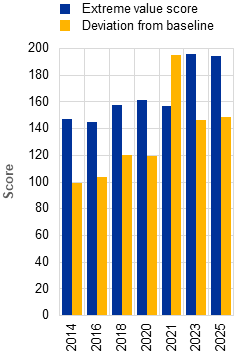
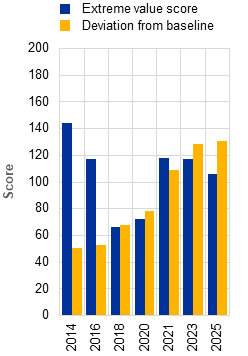
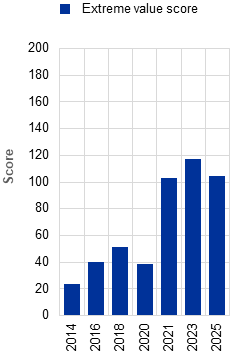
Source: ECB calculations.
Notes: The extreme value score reflects the minimum growth rate for GDP and the maximum rate for unemployment. For stock prices, it is the maximum fall in stock prices from the starting point of the adverse scenario. The deviation from the baseline score reflects the maximum difference between adverse and baseline scenarios. If the scenario exhibits an extreme value equivalent to the most severe extreme value during a historical stressful episode, it is given a score of 100. If the extreme value is instead equal to the average across mild episodes, it is given a score of 0. The deviation from baseline score has no direct historical comparison and is therefore normalised to the first value of the sample. All other values are linearly interpolated between those two points.
EA12 includes Belgium, Germany, Ireland, Greece, Spain, France, Italy, Luxembourg, Netherlands, Austria, Portugal, Finland.Chart 2
Overall severity index
a) Deviation from baseline score
b) Extreme value score
c) Capital-weighted severity index
(severity score per exercise year, EA12)
(severity score per exercise year, EA12)
(severity score per exercise year, EA12)
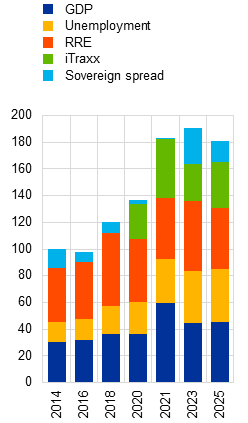
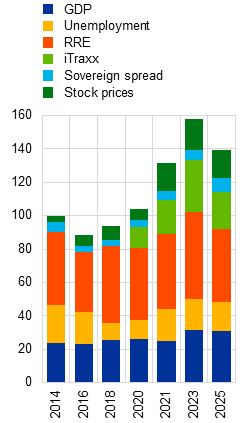
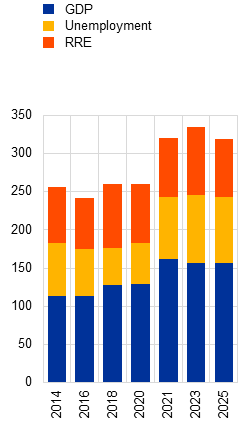
Source: ECB calculations.
Notes: The deviation from the baseline score (panel a) reflects the maximum difference between adverse and baseline scenarios. There is no baseline scenario for stock prices and therefore no deviation from baseline score for this variable. The extreme value score (panel b) generally reflects the maximum or minimum adverse value. For stock prices and residential real estate (RRE), however, this is the maximum fall from starting point. The height of the bar corresponds to the overall equal-weighted average score across all variables featured in the given chart. The size of the relative contribution from each variable is coloured. Panel c) shows the overall (average of deviation from baseline and extreme value) severity score for GDP, unemployment and RRE, the three variables for which both severity scores and capital sensitivity results are available. Sensitivities are estimated following the approach described in Caccavaio et al. (2025). Using past stress test data, this method regresses capital depletion on a variety of macro-financial variables together with business model fixed effects. The coefficients are then scaled such that each expresses the change of the dependent variable (capital depletion) following a 1 standard deviation change in the corresponding variable and then normalised such that the three weights sum to 1. The height of the bar corresponds to the average severity score of the variables weighted by the sensitivity metric. EA12 includes Belgium, Germany, Ireland, Greece, Spain, France, Italy, Luxembourg, Netherlands, Austria, Portugal, Finland.3 A forward-looking perspective: using macro-econometric models to define severity measures
3.1 Leveraging joint probability concepts to assess scenario severity and plausibility
Scenario severity and plausibility can be assessed by using joint probability models of the relevant scenario variables. The severity and plausibility of a given scenario can be judged within a joint framework to properly account for the dependency structure between variables. To this end, a vector autoregressive (VAR) model for several variables of the EBA’s stress test scenarios is used to (i) estimate co-movements among variables in a consistent framework, and (ii) provide an estimate of the joint probability of the variables.[9],[10]
Scenario plausibility can be judged by the changes to the model’s shock distribution needed to match the adverse scenario paths. From the viewpoint of a VAR model, scenarios are ultimately conditions on some or all variables of the system (at several points in time) that the model ought to match by adjusting the model’s shock distribution. This adjustment can be measured using the approach set out by Antolín-Díaz et al. (2021) that is termed the divergence metric (DM), given its close connection to the Kullback-Leibler divergence. Intuitively, it can be interpreted as judging a scenario as the outcome of a biased coin flip. A metric value of 0.5 indicates no bias, such that the adjusted shock distribution is identical to the initial one. A value of 1, by contrast, indicates that one needs to push the shock distribution very far from its unconstrained counterpart. As such, high values of this metric indicate a low degree of plausibility as the shocks that implement the adverse scenario are then unlikely under the baseline distribution. Within the context of stress test scenarios, however, this can be interpreted interchangeably with scenario severity as the adverse is typically located in the lower tail of the baseline distribution.
In simple terms, the DM measures the effort required to move the baseline scenario to recreate the variable paths of the adverse scenario. The initial shock distribution is defined to implement the annual baseline scenario paths reported in the official stress test documents.[11] The deviations from this distribution, illustrated in Chart 3, are then interpreted as a measure of scenario plausibility.[12] For the baseline scenario in Chart 3, panel a, the method yields a shock distribution (yellow curve) with a slightly higher mean but close to the unconditional one (blue curve), which follows a standard normal distribution. In a second step shown in Chart 3, panel b, the shock distribution is shifted to the left to generate the shock distribution for the adverse scenario (red curve). The DM then computes the distance between the baseline and the adverse shock distribution. The final measure is computed across euro area countries, periods and variables.
Chart 3
Adjustment of baseline scenario paths to match adverse scenario conditions
a) Baseline and adverse paths for the EBA 2025 scenarios
(growth rates, percentages)
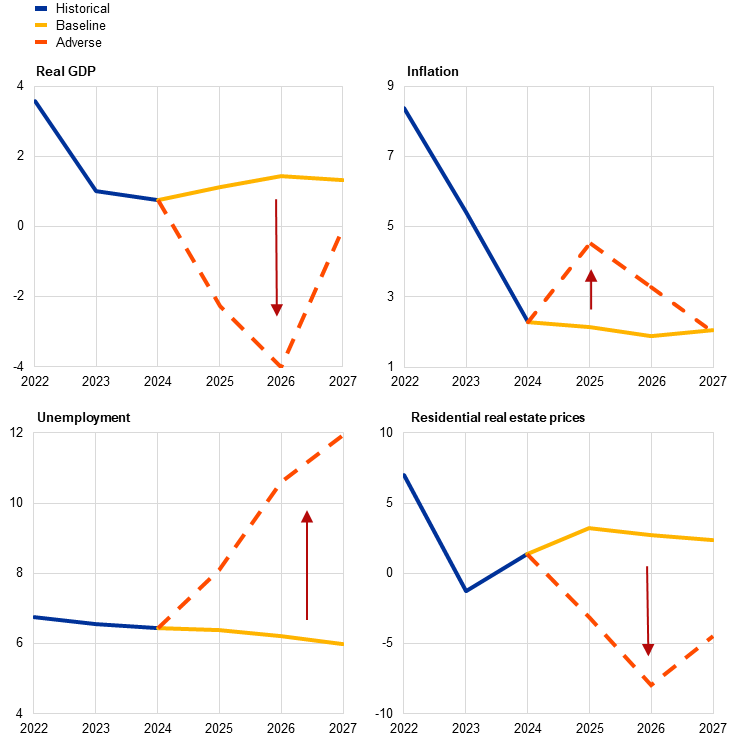
b) Posterior shock distributions for different forecasts of the EBA 2025 scenarios
(densities)
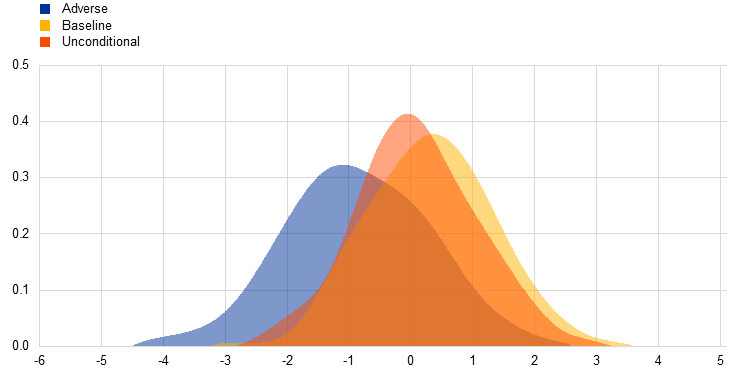
Source: ECB calculations.
Notes: Panel a) illustrates how the baseline path (blue-dotted line) is adjusted to the adverse path (yellow-dashed line). The solid blue line depicts historical data. Panel b) shows how the shock distribution for a randomly selected shock and country in a single period is adjusted from the unconditional distribution to the baseline distribution, and then further to the adverse distribution.The DM indicates that scenario severity increased over time but declined with the EBA’s 2025 stress test adverse scenario. Chart 4, panel a) compares the model-based scenario DM for the 2020, 2021, 2023 and 2025 exercises for the euro area. For the 2020 adverse scenario, the DM comes out at 0.81. In the following exercise (2021), scenario severity then slightly increased as shown by the rightward shift from the blue to the yellow distribution. The 2023 exercise saw a substantial increase in severity (the red distribution) with a modal metric around 0.93. The latest scenario (2025) features a severity metric close to 0.90, in the ballpark of 2023 but slightly smaller. For reference, Antolín-Díaz et al. (2021) find a scenario with a modal value of 0.83 to be “… unlikely but not completely implausible”. Hence, the DM values obtained here seem reasonable, not least because we are analysing severe stress test scenarios.[13]
The EBA’s 2025 adverse scenario provides a well-calibrated level of severity across euro area countries. Chart 4, panel b) focuses on the cross-country dispersion of the model-based scenario plausibility metric. The 2021 scenario features a marked increase in dispersion compared with the 2020 vintage, consistent with high uncertainty following the pandemic period shortly before. Both vintages feature plausible, and hence rather mild, country-level scenarios. The 2023 scenario vintage is more severe across the board, as shown by an upward shift and compression of the distribution. The 2025 scenario features somewhat higher dispersion than the 2023 vintage and overall turns out to be more plausible/less severe. However, the 2025 DM is still close to the 2023 vintage DM. The 2025 scenario lies above 0.8 in the cross-section, a value that, as illustrated in the previous paragraph, can be considered a sensible lower bound on a scenario believed to be “severe, but plausible”. As such, the 2025 scenario seems to provide a consistently severe scenario in the cross-section.
Chart 4
Scenario plausibility
a) Posterior distributions of plausibility metrics across scenario vintages
b) Cross-sectional posterior distribution of plausibility metrics across scenario vintages
(densities)
(probability)
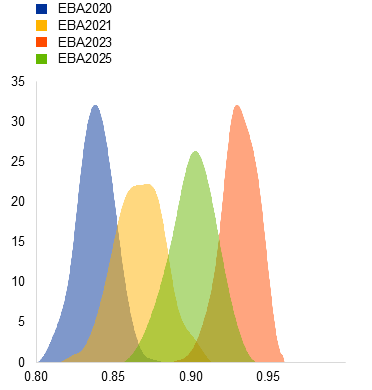
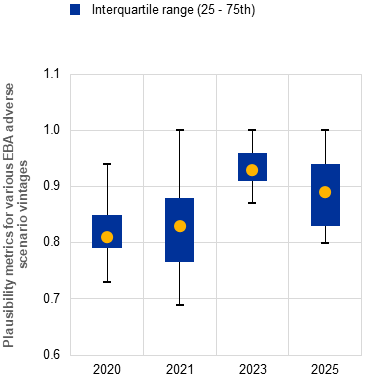
Source: ECB calculations.
Notes: Panel a) shows posterior distributions for the plausibility metrics discussed in the main text across the four most recent EBA stress test scenario vintages. Panel b) shows the cross-country distribution of the posterior modes of the plausibility distributions. The support of the scale in both panels ranges between 0 and 1. Note that the modal value in panel a) need not coincide with the median values in panel b. In panel a, the country-specific measures are aggregated into an aggregate measure, whereas panel b) compares the cross-sectional distribution of modal severity measures.3.2 Risk-adjusted forward-looking severity: adjusting severity by considering risks to financial stability
When assessing the severity of a scenario, an economy’s level of financial risk at the start of the scenario horizon also needs to be accounted for. The level of financial risk affects how shocks propagate through the economy. Overall, when risks are higher, economic and financial shocks are amplified and are likely to lead to stronger downturns. This section assesses the severity of the stress test scenarios by using non-linear macro-econometric frameworks designed to evaluate the relationship between the level of risk and the macroeconomic outlook. In this way, the forward-looking severity assessment can be adjusted to take account of financial conditions and the prevailing level of systemic risks.
3.2.1 Combining forward-looking metrics with financial conditions within a growth-at-risk approach
Adverse scenarios are designed to reflect financial stability risks to which the EU banking sector is exposed.[14] A complementary approach to assessing the severity of these adverse scenarios therefore focuses explicitly on the risks that underpin the design of a specific scenario. This approach builds on the growth-at-risk framework (see Adrian et al., 2019, and Figueres and Jarocisńki, 2020), which entails constructing the predictive distribution of GDP growth conditional on the financial risks embedded in the scenario. The severity of the scenario is then assessed by comparing the projected GDP path under the scenario against the range of potential adverse GDP outcomes implied by the financial risks associated with this scenario.
The level of the financial risk associated with the scenario is measured by a financial stress index (FSI). Using the methodology of the Composite Indicator of Systemic Stress (CISS) presented in Holló et al. (2012),[15] an FSI is built to match the path of the adverse scenario variables for the euro area (Chart 5). The key advantage of the FSI lies in its ability not only to capture historical events of financial stress (e.g. the 2008 global financial crisis and the 2011 euro area crisis) but also to gauge the level of financial risk embedded in the scenario shocks. As shown in Chart 5, the 2023 adverse scenario starts from a situation of elevated risk in 2022 and exhibits a persistent increase in financial stress levels over the three-year scenario horizon. By contrast, the 2025 adverse scenario starts from a situation of relatively low financial risk in 2024, with a pronounced increase in financial stress that diminishes slightly towards the end of the scenario horizon.
Chart 5
Euro area financial stress index
Historical index and scenario financial stress
(level index)
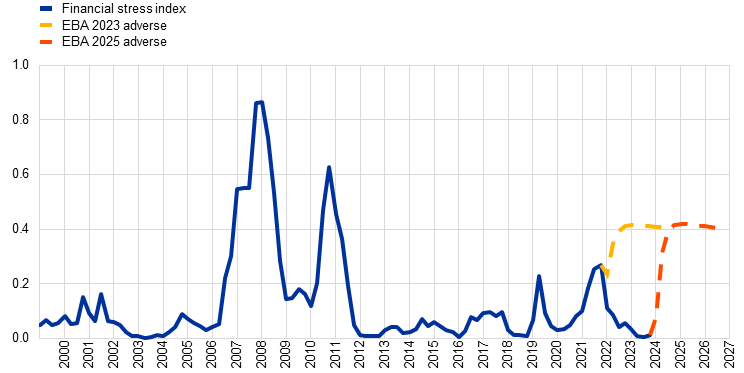
Source: ECB calculations.
Notes: The blue solid line depicts the quarterly euro area financial stress index (FSI) gauging events of systemic stress in the financial sector for the sample period Q1 2000-Q2 2024. The dashed lines show the FSI indicator based on the three-year stress test scenario shocks for the 2023 stress test (yellow) and the 2025 stress test (red).A growth-at-risk measure of severity can be obtained by estimating density forecasts for GDP conditional on the level of financial risk conveyed in the scenario. A set of adverse outcomes can be derived by projecting future GDP conditional on the FSI via quantile regression. In particular, the outcomes corresponding to the predictive lower tail at the 5th, 10th and 20th percentiles are considered.[16] Chart 6 shows the predictive lower tails corresponding to the 2025 (panel a) and the 2023 (panel b) adverse scenarios.
Chart 6
Scenario growth-at-risk
a) 2025 stress test predictive lower tails
b) 2023 stress test predictive lower tails
(real GDP level, index: 2024 = 100)
(real GDP level, index: 2022 = 100)
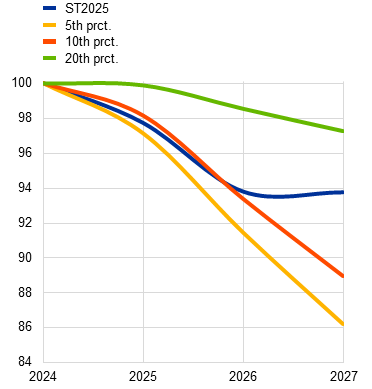
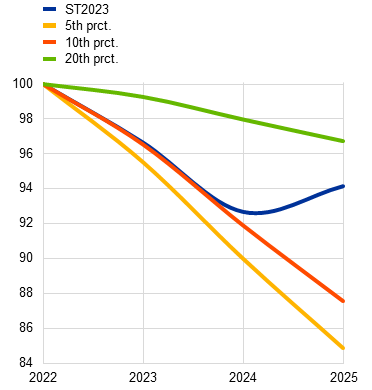
Source: ECB calculations.
Notes: The red, green and yellow lines describe the predictive lower tails of the annual euro area real GDP level index for the 20th, 10th and 5th percentile, estimated using a growth-at-risk model enriched with a financial stress index that gauge the scenario-implied risks. The blue lines show the figures for GDP corresponding to the adverse scenario for the 2025 stress test (panel a) and the 2023 stress test (panel b).From a growth-at-risk perspective, the 2025 adverse scenario appears more severe than the 2023 scenario. Chart 6 provides three main insights. First, the GDP paths for both the 2023 and the 2025 adverse scenarios lie within their respective predictive lower tails, indicating that, while both scenarios depict severe stress conditions, they remain plausible within the context of the underlying risks. Second, the predictive lower tails for the 2023 scenario are wider than those for the 2025 scenario, reflecting the elevated financial risk observed in 2022, which determined the initial conditions of the 2023 scenario as shown in Chart 6. Third, the GDP path for the 2025 scenario extends deeper into its predictive lower tail than the 2023 scenario, pointing to the 2025 adverse scenario having a higher degree of severity.
3.2.2 Combining forward-looking metrics with cyclical systemic risks in a local projection approach
The evolution of indebtedness and systemic risk levels plays a crucial role when assessing the severity of stress test scenarios. The level of cyclical systemic risks can affect the way macroeconomic dynamics propagate in the economy. Several studies highlight that when the level of debt is high, shocks are amplified in the economy, as debt plays the role of financial accelerator (see Bernanke at al., 1999, and Kiyotaki and Moore, 1997). When agents are more indebted, external shocks may affect their debt repayment capacity and force them to reduce spending, further amplifying the initial fluctuations.[17] Higher systemic risks may affect severity assessments, as in times of higher risks and higher vulnerability, the same scenario would be triggered by relatively smaller shocks than in a period of lower systemic risks.
When systemic risk levels are high, the same shocks tend to generate stronger recessions than in periods of low risk. A non-linear macroeconomic model is first utilised to examine how systemic risks influence the propagation of macroeconomic shocks (see Couaillier and Scalone, 2024). The model assumes that the economy smoothly transitions between periods of high and low levels of cyclical systemic risk, as captured by the systemic risk indicator (SRI) (see Lang and Forletta, 2020). Thanks to its non-linear structure, the SRI generates state-dependent dynamics. Chart 7, panel a) illustrates how under conditions of elevated cyclical systemic risk, the impact of shocks is overall significantly amplified, in line with the presence of a financial accelerator in the economy.
The level of cyclical systemic risk has decreased over recent years, driven by slower credit growth and downward asset price corrections. At the beginning of 2021, the observed SRI was high, at 0.06, explained by significantly expanding debt, falling asset price valuations and increasing private sector indebtedness. The SRI then started to fall from this peak. This downward trend continued during the period of monetary policy tightening in line with a deceleration in credit growth and an asset price correction. At the beginning of 2025, the euro area’s SRI was lower than in 2023 and 2021.
Taking into account cyclical systemic risk levels, the 2025 scenario emerges as more severe than the 2023 and 2021 scenarios. The model’s non-linear dynamics are used to compare the severity of the scenarios across the different years, once the level of cyclical systemic risk is incorporated. First, the non-linear model is used to match the negative cumulative GDP growth of the EBA’s 2025 scenario, including the risk level observed during the scenario calibration period. The same set of shocks required to match the 2025 scenario downturn is then used to compute the hypothetical cumulative GDP growth considering the risk levels for 2023 and 2021. Chart 7, panel b) reports the cumulative GDP growth under the original EBA adverse scenarios over the three-year stress test horizon for the 2021, 2023 and 2025 exercises (blue bars) and the hypothetical cumulative growth for each scenario (yellow bars). If the same set of shocks used in 2025, hence the same severity, had been used in the previous exercises, the cumulative GDP growth would have been 0.9 percentage points higher in 2023 and 3.0 higher in 2021.
Chart 7
Severity assessment with cyclical risk correction
a) Macro dynamics across different risk levels
b) GDP growth across EBA scenarios: unadjusted and corrected by risk level
(percentage points deviation from the starting point)
(percentage points deviation from the starting point)
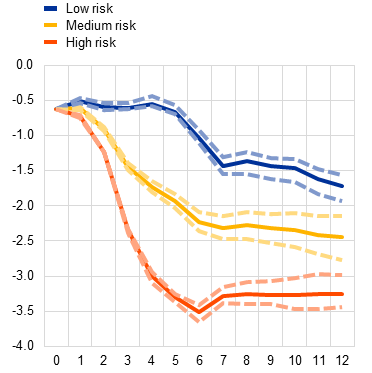
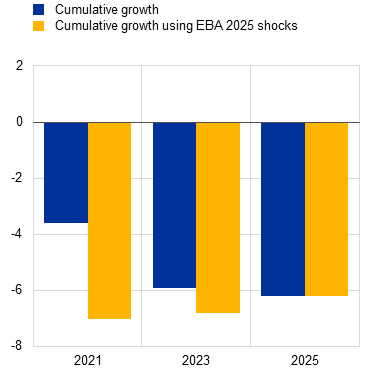
Source: ECB calculations.
Notes: Panel a) depicts the impulse responses of the economy to a set of 1 standard deviation recessionary shocks. The model is a variant of Couaillier and Scalone (2024). The chart reports the responses under low risk (25th percentile of the historical distributions, blue), medium risk (50th percentile of the historical distribution, yellow) and high risk (75th percentile of the historical distribution, red). Panel b) reports the cumulative GDP growth under the EBA’s adverse scenarios (blue bars) for 2021, 2023 and 2025, and the corresponding hypothetical cumulative growth if the same shocks used to generate the 2025 cumulative GDP growth were applied, once the risk levels of the corresponding year are incorporated (yellow bars).4 Conclusion
This article introduces a comprehensive framework for assessing the severity and plausibility of the adverse scenarios used in the EU-wide stress tests, incorporating multiple dimensions to ensure a robust evaluation. First, backward-looking indicators are used to assess scenario severity by benchmarking the adverse scenario outcomes against historical crisis episodes. This backward-looking leg focuses on two critical dimensions: (i) the deviation of adverse outcomes in variables such as real GDP, unemployment and inflation from the baseline scenario; and (ii) the levels of these variables in the adverse scenario. These dimensions offer insights into both the relative and the absolute levels of stress embedded in the scenarios. A forward-looking leg assesses the severity of the scenario in terms of the future density forecasts. This leg relies on a model-based severity index constructed by leveraging a macroeconomic VAR model and the concept of scenario plausibility. The resulting plausibility metric evaluates how far an adverse scenario deviates from baseline expectations, providing an intuitive measure of their alignment with historical regularities and hence their realism.
The forward-looking severity assessment can be expanded to consider how systemic risks affect macroeconomic dynamics. To this end, the article presents a methodology for evaluating scenario severity that incorporates prevailing financial conditions and systemic risks. These approaches focus on cumulative GDP growth and give rise to two complementary measures. The first shows how financial conditions can affect severity assessments. A growth-at-risk approach compares the location of the scenario-implied GDP path in the lower tails of predictive distribution, providing insights into the severity of adverse outcomes relative to expected risks. The second measure studies how systemic cyclical risks can affect severity assessments. This approach computes how the cumulative GDP growth of the 2023 and 2021 scenarios would have differed if the same shocks used to generate the 2025 cumulative GDP growth had been used in 2021 and 2023, taking into account the relatively higher levels of systemic risk in those periods.
This framework finds that the adverse scenarios used in the EU-wide stress tests have become more severe over time. According to the indicator-based approach and the model-based plausibility index, scenario severity reached a peak in 2023 before declining slightly in 2025. Taking into account the financial risk environment that prevailed when the scenarios were devised, it turns out that the GDP path can be considered more severe under the 2025 scenario than under the 2023 scenario since it is located further into the tail of its predictive distribution. Moreover, when adjusting for systemic risk, the 2025 scenario appears to be the most severe, even surpassing the 2023 scenario in terms of its risk-weighted severity. This highlights the importance of considering systemic risk levels when evaluating scenario severity.
The proposed methodologies provide a multidimensional, rigorous framework for evaluating the severity and plausibility of stress test scenarios. By benchmarking against historical episodes, employing macroeconomic modelling and applying systemic risk adjustments, this framework helps scenarios to be devised that are both severe and plausible. This makes it easier to assess the resilience of the banking sector to adverse macro-financial developments while improving the clarity, credibility and comparability of stress test results.
References
Adrian, T., Boyarchenko, N. and Giannone, D. (2019), “Vulnerable Growth”, American Economic Review, Vol. 109, No 4, April, pp. 1263-1289.
Antolín-Díaz, J., Petrella, I. and Rubio-Ramírez, J.F. (2021), “Structural scenario analysis with SVARs”, Journal of Monetary Economics, Vol. 117, January, pp. 798-815.
Bernanke, B.S., Gertler, M. and Gilchrist, S. (1999), “The financial accelerator in a quantitative business cycle framework”, Handbook of Macroeconomics, Vol. 1, pp. 1341-1393.
Couaillier, C. and Scalone, V. (2024), “Risk-to-buffer: setting cyclical and structural banks capital requirements through stress tests”, Working Paper Series, No 2966, ECB.
Durdu, B, Edge, R. and Schwindt, D. (2017), “Measuring the Severity of Stress-Test Scenarios”, FEDS Notes, Board of Governors of the Federal Reserve System, 5 May.
Figueres, J.M. and Jarociński, M. (2020), “Vulnerable growth in the euro area: Measuring the financial conditions”, Economics Letters, Vol. 191(C), June.
Geweke, J. (1993), “Bayesian treatment of the independent Student‐t linear model”, Journal of Applied Econometrics, Vol. 8, Supplement, December, pp. S19-S40.
Holló, D., Kremer, M. and Lo Duca, M. (2012), “CISS – a composite indicator of systemic stress in the financial system”, Working Paper Series, No 1426, ECB.
Jarociński, M. (2010), “Responses to monetary policy shocks in the east and the west of Europe: a comparison”, Journal of Applied Econometrics, Vol. 25, Issue 5, pp. 833-868.
Kiyotaki, N. and Moore, J. (1997), “Credit Cycles”, Journal of Political Economy, Vol. 105, No 2, April, pp. 211-248.
Lang, J.H. and Forletta, M. (2020), “Cyclical systemic risk and downside risks to bank profitability”, Working Paper Series, No 2405, ECB.
Ter Steege, L. (2024), “Variational inference for Bayesian panel VAR models”, Working Paper Series, No 2991, ECB.
Continue Reading
